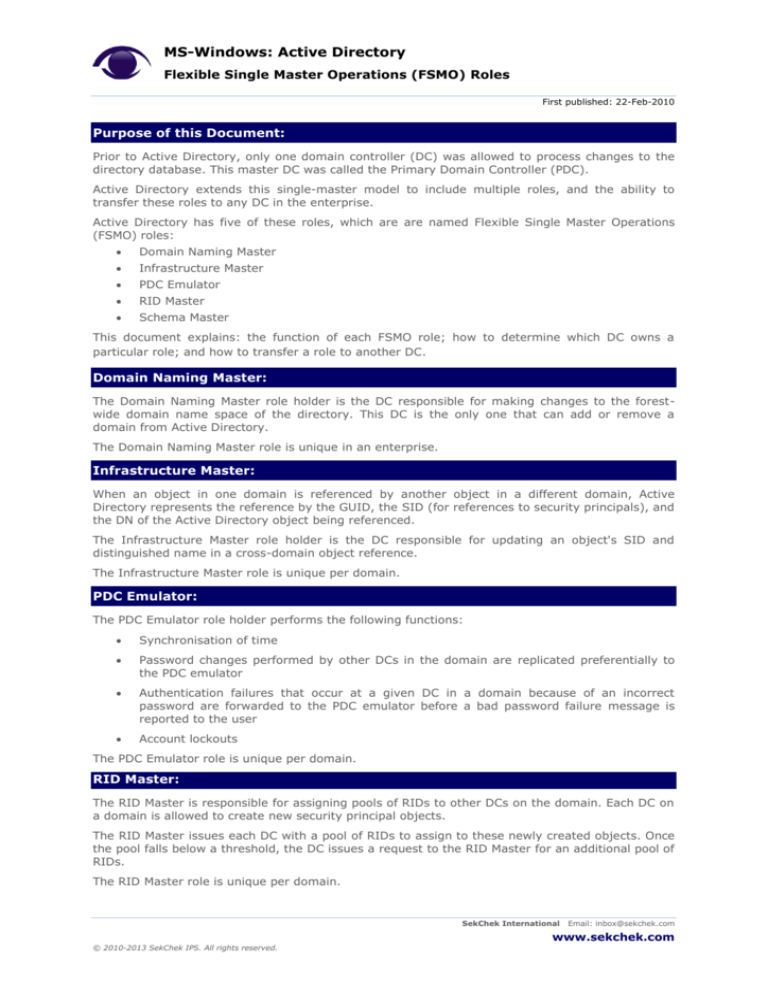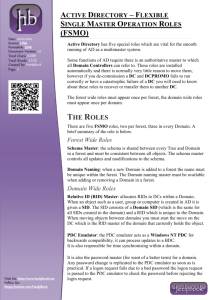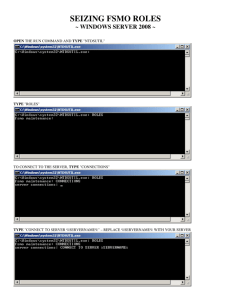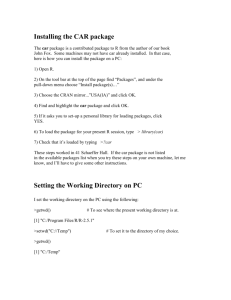
MS-Windows: Active Directory
Flexible Single Master Operations (FSMO) Roles
First published: 22-Feb-2010
Purpose of this Document:
Prior to Active Directory, only one domain controller (DC) was allowed to process changes to the
directory database. This master DC was called the Primary Domain Controller (PDC).
Active Directory extends this single-master model to include multiple roles, and the ability to
transfer these roles to any DC in the enterprise.
Active Directory has five of these roles, which are are named Flexible Single Master Operations
(FSMO) roles:
Domain Naming Master
Infrastructure Master
PDC Emulator
RID Master
Schema Master
This document explains: the function of each FSMO role; how to determine which DC owns a
particular role; and how to transfer a role to another DC.
Domain Naming Master:
The Domain Naming Master role holder is the DC responsible for making changes to the forestwide domain name space of the directory. This DC is the only one that can add or remove a
domain from Active Directory.
The Domain Naming Master role is unique in an enterprise.
Infrastructure Master:
When an object in one domain is referenced by another object in a different domain, Active
Directory represents the reference by the GUID, the SID (for references to security principals), and
the DN of the Active Directory object being referenced.
The Infrastructure Master role holder is the DC responsible for updating an object's SID and
distinguished name in a cross-domain object reference.
The Infrastructure Master role is unique per domain.
PDC Emulator:
The PDC Emulator role holder performs the following functions:
Synchronisation of time
Password changes performed by other DCs in the domain are replicated preferentially to
the PDC emulator
Authentication failures that occur at a given DC in a domain because of an incorrect
password are forwarded to the PDC emulator before a bad password failure message is
reported to the user
Account lockouts
The PDC Emulator role is unique per domain.
RID Master:
The RID Master is responsible for assigning pools of RIDs to other DCs on the domain. Each DC on
a domain is allowed to create new security principal objects.
The RID Master issues each DC with a pool of RIDs to assign to these newly created objects. Once
the pool falls below a threshold, the DC issues a request to the RID Master for an additional pool of
RIDs.
The RID Master role is unique per domain.
SekChek International
© 2010-2013 SekChek IPS. All rights reserved.
Email: inbox@sekchek.com
www.sekchek.com
MS-Windows: Active Directory
Flexible Single Master Operations (FSMO) Roles
First published: 22-Feb-2010
Schema Master:
The Schema Master is responsible for processing updates to the AD schema. Once the Schema
Master updates the AD schema, these changes are replicated to other DCs on the domain.
The Schema Master role is unique in an enterprise.
Checking and transferring the FSMO roles assigned to DCs:
This section illustrates how to check and change the FSMO roles assigned to DCs using Windows’
GUI interface. The screenshots provided are from a Windows 2003 DC.
1. RID Master, PDC Emulator and Infrastructure Master Roles
Use the Active Directory Users and Computers interface to determine
which DCs hold the RID Master, PDC Emulator and Infrastructure
Master roles in a domain.
Click on the domain (e.g. olympus.com), select Operations Masters.
To assign the role to another DC, you must connect to the domain via
that DC.
Right-click on the domain and select Connect to Domain Controller.
Use the Operations Masters interface to pass on the relevant role.
2. Domain Naming Master Role
Use the Active Directory Domains and Trusts interface to determine
which DC in the forest has the Domain Naming Master role.
Click Active Directory Domains and Trusts, select Operations Master.
To assign the role to a different DC, you must connect to the target DC.
Right-click on Active Directory Domains and Trusts and select Connect
to Domain Controller.
3. Schema Master Role
You can use the Schema Master tool to transfer the Schema Master role. Note that the
Schmmgmt.dll dynamic-link library must be registered in order to make the Schema Master
tool available as an MMC snap-in.
Registering the Schema Tool:
1. Go to the Command Prompt: Click Start, select Run.
2. Type regsvr32 schmmgmt.dll, click OK. A message should be displayed stating that the
registration was successful.
Transferring the Schema Master Role:
1.
2.
3.
4.
Click Start, click Run, type mmc, click OK
Click File -> Add/Remove Snap-in
Add Active Directory Schema
Right-click Active Directory Schema, select Change Domain
Controller
5. Click Specify Domain Controller, type the name of the
domain controller that will be the new role holder, click OK
6. Right-click Active Directory Schema, select Operation
Master
SekChek International
© 2010-2013 SekChek IPS. All rights reserved.
Email: inbox@sekchek.com
www.sekchek.com
MS-Windows: Active Directory
Flexible Single Master Operations (FSMO) Roles
First published: 22-Feb-2010
Glossary of terms used in this document:
FSMO: Flexible Single Master Operations
GUID: Globally Unique Identifier
PDC: Primary Domain Controller
RID: Relative Identifier
SID: Security Identifier
Additional Resources:
Microsoft Knowledge-Base articles:
Windows 2000 Active Directory FSMO roles. http://support.microsoft.com/kb/197132
Using Ntdsutil.exe to transfer or seize
http://support.microsoft.com/kb/255504
FSMO
roles
to
a
domain
controller.
This paper was written by Sanjay Pather, an Operations
Manager at SekChek Information Protection Services.
Sanjay is responsible for the quality of SekChek reports
and research and testing of security controls on the various
platforms supported by SekChek.
SekChek International
© 2010-2013 SekChek IPS. All rights reserved.
Email: inbox@sekchek.com
www.sekchek.com












